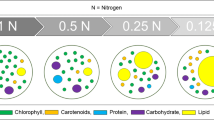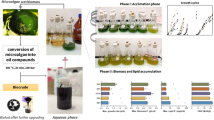Abstract
Acetic acid derived from fast pyrolysis of lignocellulosic biomass is a promising substrate for microalgae fermentation for producing lipid-rich biomass. However, crude pyrolytic acetic acid solution contains various toxic compounds inhibiting algal growth. It was hypothesized that such an inhibition was mainly due to the cell membrane damage. In this work, the cell membrane property of algal cells was evaluated at various conditions to elucidate the mechanisms of inhibition caused by the pyrolytic substrate solution. It was found that acetic acid itself served a carbon source for boosting algal cell growth but also caused cell membrane leakage. The acetic acid concentration for highest cell density was 4 g/L. Over-liming treatment of crude pyrolytic acetic acid increased the algal growth with a concurrent reduction of cell membrane leakage. Directed evolution of algal strain enhanced cell membrane integrity and thus increased its tolerance to the toxicity of the crude substrate. Statistical analysis shows that there was a significant correlation between the cell growth performance and the cell membrane integrity (leakage) but not membrane fluidity. The addition of cyto-protectants such as Pluronic F68 and Pluronic F127 enhanced the cell membrane integrity and thus, resulted in enhanced cell growth. The transmission electron microscopy (TEM) of algal cells visually confirmed the cell membrane damage as the mechanism of the pyrolytic substrate inhibition. Collectively, this work indicates that the cell membrane is one major reason for the toxicity of pyrolytic acetic acid when being used for algal culture. To better use this pyrolytic substrate, cell membrane of the microorganism needs to be strengthened through either strain improvement or addition of membrane protectant reagents.







Similar content being viewed by others
References
Brown TR, Thilakaratne R, Brown RC, Hu G (2013) Techno-economic analysis of biomass to transportation fuels and electricity via fast pyrolysis and hydroprocessing. Fuel 106:463–469. doi:10.1016/j.fuel.2012.11.029
Campos FM, Couto JA, Figueiredo AR, Tóth IV, Rangel AOSS, Hogg TA (2009) Cell membrane damage induced by phenolic acids on wine lactic acid bacteria. Int J Food Microbiol 135(2):144–151
Chan JKS, Duff SJB (2010) Methods for mitigation of bio-oil extract toxicity. Bioresource Technol 101(10): 3755–3759. doi:10.1016/j.biortech.2009.12.054
Chang D, Yu Z, Islam Z, Zhang H (2015) Mathematical modeling of the fermentation of acid-hydrolyzed pyrolytic sugars to ethanol by the engineered strain Escherichia coli ACCC 11177. Appl Microbiol Biot 99(9):4093–4105. doi:10.1007/s00253-015-6475-7
Chi Z, Rover M, Jun E, Deaton M, Johnston P, Brown RC, Wen Z, Jarboe LR (2013) Overliming detoxification of pyrolytic sugar syrup for direct fermentation of levoglucosan to ethanol. Bioresource Technol 150:220
Cristani M, D'Arrigo M, Mandalari G, Castelli F, Sarpietro MG, Micieli D, Venuti V, Bisignano G, Saija A, Trombetta D (2007) Interaction of four monoterpenes contained in essential oils with model membranes: implications for their antibacterial activity. J Agr Food Chem 55(15):6300–6308. doi:10.1021/jf070094x
Heipieper HJ, Weber FJ, Sikkema J, Keweloh H, de Bont JAM (1994) Mechanisms of resistance of whole cells to toxic organic solvents. Trends Biotechnol 12(10):409–415
Hlavova M, Turoczy Z, Bisova K (2015) Improving microalgae for biotechnology–from genetics to synthetic biology. Biotechnol Adv 33(6 Pt 2):1194–1203. doi:10.1016/j.biotechadv.2015.01.009
Hyldgaard M, Mygind T, Meyer RL (2012) Essential oils in food preservation: mode of action, synergies, and interactions with food matrix components. Front Microbiol 3:12. doi:10.3389/fmicb.2012.00012
Jarboe L, Wen Z, Choi D, Brown R (2011a) Hybrid thermochemical processing: fermentation of pyrolysis-derived bio-oil. Appl Microbiol Biot 91(6):1519–1523. doi:10.1016/j.coche.2011.08.003
Jarboe LR, Liu P, Royce LA (2011b) Engineering inhibitor tolerance for the production of biorenewable fuels and chemicals. Curr Opin Chem Eng 1(1):38–42. doi:10.1007/s00253-011-3495-9
Krebs HA, Wiggins D, Stubbs M, Sols A, Bedoya F (1983) Studies on the mechanism of the antifungal action of benzoate. Biochem J 214(3):657–663. doi:10.1042/bj2140657
Lambert RJW, Skandamis PN, Coote PJ, Nychas GJE (2001) A study of the minimum inhibitory concentration and mode of action of oregano essential oil, thymol and carvacrol. J Appl Microbiol 91(3):453–462. doi:10.1046/j.1365-2672.2001.01428.x
Li Y, Han D, Hu G, Dauvillee D, Sommerfeld M, Ball S, Hu Q (2010a) Chlamydomonas starchless mutant defective in ADP-glucose pyrophosphorylase hyper-accumulates triacylglycerol. Metab Eng 12(4):387–391
Li Y, Han D, Hu G, Sommerfeld M, Hu Q (2010b) Inhibition of starch synthesis results in overproduction of lipids in Chlamydomonas reinhardtii. Biotechnol Bioeng 107(2):258–268. doi:10.1016/j.ymben.2010.02.002
Lian J, Garcia-Perez M, Chen S (2013) Fermentation of levoglucosan with oleaginous yeasts for lipid production. Bioresource Technol 133:183–189. doi:10.1016/j.biortech.2013.01.031
Lian J, Garcia-Perez M, Coates R, Wu H, Chen S (2012) Yeast fermentation of carboxylic acids obtained from pyrolytic aqueous phases for lipid production. Bioresource Technol 118:177–186
Liang Y (2012) Lipid products from agriculture by-products and pyrolytic oil. Doctoral dissertation, Iowa State University
Liang Y, Zhao X, Chi Z, Rover M, Johnston P, Brown R, Jarboe L, Wen Z (2013) Utilization of acetic acid- rich pyrolytic bio- oil by microalga Chlamydomonas reinhardtii: reducing bio-oil toxicity and enhancing algal toxicity tolerance. Bioresource Technol 133:500. doi:10.1016/j.biortech.2013.01.134
Lin R, Cheng J, Ding L, Song W, Zhou J, Cen K (2015) Inhibitory effects of furan derivatives and phenolic compounds on dark hydrogen fermentation. Bioresource Technol 196:250–255. doi:10.1016/j.biortech.2015.07.097
Luque L, Westerhof R, Van Rossum G, Oudenhoven S, Kersten S, Berruti F, Rehmann L (2014) Pyrolysis based bio-refinery for the production of bioethanol from demineralized ligno-cellulosic biomass. Bioresource Technol 161:20–28. doi:10.1016/j.biortech.2014.03.009
Monlau F, Sambusiti C, Barakat A, Quéméneur M, Trably E, Steyer JP, Carrère H (2014) Do furanic and phenolic compounds of lignocellulosic and algae biomass hydrolyzate inhibit anaerobic mixed cultures? A comprehensive review. Biotechnol Adv 32(5):934–951. doi:10.1016/j.biotechadv.2014.04.007
Murhammer DW, Goochee CF (1988) Scaleup of insect cell cultures: protective effects of pluronic F-68. Nat Biotech 6(12):1411–1418
Palmqvist E, Hahn-Hägerdal B (2000) Fermentation of lignocellulosic hydrolysates. II: inhibitors and mechanisms of inhibition. Bioresource Technol 74(1):25–33. doi:10.1016/s0960-8524(99)00161-3
Pearce AK, Booth IR, Brown AJP (2001) Genetic manipulation of 6-phosphofructo-1-kinase and fructose 2,6-bisphosphate levels affects the extent to which benzoic acid inhibits the growth of Saccharomyces cerevisiae. Microbiology 147(2):403–410. doi:10.1099/00221287-147-2-403
Piper P, Calderon CO, Hatzixanthis K, Mollapour M (2001) Weak acid adaptation: the stress response that confers yeasts with resistance to organic acid food preservatives. Microbiology 147(10):2635–2642
Piper PW (1999) Yeast superoxide dismutase mutants reveal a pro-oxidant action of weak organic acid food preservatives. Free Radical Bio Med 27(11):1219–1227
Piper PW, Ortiz-Calderon C, Holyoak C, Coote P, Cole M (1997) Hsp30, the integral plasma membrane heat shock protein of Saccharmyces cerevisiae, is a stress-inducible regulator of plasma membrane H(+)-ATPase. Cell Stress Chaperon 2(1):12–24
Pollard AS, Rover MR, Brown RC (2012) Characterization of bio-oil recovered as stage fractions with unique chemical and physical properties. J Anal Appl Pyrol 93(0):129–138. doi:10.1016/j.jaap.2011.10.007
Rao A, Zhang Y, Muend S, Rao R (2010) Mechanism of antifungal activity of terpenoid phenols resembles calcium stress and inhibition of the TOR pathway. Antimicrob Agents Ch 54(12):5062–5069
Rover MR, Johnston PA, Jin T, Smith RG, Brown RC, Jarboe L (2014) Production of clean pyrolytic sugars for fermentation. Chem Sus Chem 7(6):1662–1668. doi:10.1002/cssc.201301259
Royce L, Liu P, Stebbins M, Hanson B, Jarboe L (2013) The damaging effects of short chain fatty acids on Escherichia coli membranes. Appl Biochem Biotech 97(18):8317–8327
Royce LA, Yoon JM, Chen Y, Rickenbach E, Shanks JV, Jarboe LR (2015) Evolution for exogenous octanoic acid tolerance improves carboxylic acid production and membrane integrity. Metab Eng 29:180–188. doi:10.1007/s00253-013-5113-5
Shen Y, Jarboe L, Brown R, Wen Z (2015) A thermochemical–biochemical hybrid processing of lignocellulosic biomass for producing fuels and chemicals. Biotechnol Adv 33(8):1799–1813. doi:10.1016/j.biotechadv.2015.10.006
Sukhbaatar B, Li Q, Wan C, Yu F, Hassan EB, Steele P (2014) Inhibitors removal from bio-oil aqueous fraction for increased ethanol production. Bioresource Technol 161:379–384. doi:10.1016/j.biortech.2014.03.051
Wang H, Livingston D, Srinivasan R, Li Q, Steele P, Yu F (2012) Detoxification and fermentation of pyrolytic sugar for ethanol production. Appl Biochem Biotech 168(6):1568–1583. doi:10.1007/s12010-012-9879-1
Work VH, Radakovits R, Jinkerson RE, Meuser JE, Elliott LG, Vinyard DJ, Laurens LM, Dismukes GC, Posewitz MC (2010) Increased lipid accumulation in the Chlamydomonas reinhardtii sta7-10 starchless isoamylase mutant and increased carbohydrate synthesis in complemented strains. Eukaryot Cell 9(8):1251–1261. doi:10.1128/EC.00075-10
Wu J (1995) Mechanisms of animal cell damage associated with gas bubbles and cell protection by medium additives. J Biotechnol 43(2):81–94. doi:10.1016/0168-1656(95)00133-7
Zhao X, Chi Z, Rover M, Brown R, Jarboe L, Wen Z (2013) Microalgae fermentation of acetic acid- rich pyrolytic bio- oil: reducing bio- oil toxicity by alkali treatment. Environ Prog Sustain Energy 32(4):955–961. doi:10.1002/ep.11813
Zhao X, Davis K, Brown R, Jarboe L, Wen Z (2015) Alkaline treatment for detoxification of acetic acid-rich pyrolytic bio-oil for microalgae fermentation: effects of alkaline species and the detoxification mechanisms. Biomass Bioenerg 80:203–212
Author information
Authors and Affiliations
Corresponding author
Ethics declarations
This article does not contain any studies with human participants or animals performed by any of the authors.
Funding
This study was funded by NSF Energy for Sustainability (CBET-1133319) and Iowa Energy Center (no. 12-06).
Conflict of interest
The authors declare that they have no conflict of interests.
Rights and permissions
About this article
Cite this article
Zhao, X., Jarboe, L. & Wen, Z. Utilization of pyrolytic substrate by microalga Chlamydomonas reinhardtii: cell membrane property change as a response of the substrate toxicity. Appl Microbiol Biotechnol 100, 4241–4251 (2016). https://doi.org/10.1007/s00253-016-7439-2
Received:
Revised:
Accepted:
Published:
Issue Date:
DOI: https://doi.org/10.1007/s00253-016-7439-2




